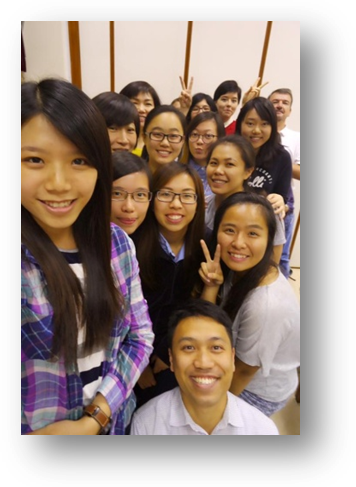PEOPLE |
|
Mr. CHAN Chi Leung (Chàhn sīn sāang, K. Chan) Division Head of Cantonese Programme Division, Continuing Education Section
|
 |
Editor’s note: There is a teacher in CLC whose appearance has deceived new students to regard him as a foreign student. He is a pure Chinese locally born and bred in Hong Kong. He has been serving as a Cantonese teacher in CLC for over 10 years and has taught to students from all walks of life. He then served in the capacity of division head in the Cantonese division of the Continuing Education Section since 2012. In this issue of PEOPLE, Mr. Chan is giving us a glimpse into Cantonese teaching and learning.
Specialized in English language and linguistics, why did you have strong interest in language learning?
Back in my secondary school time, I found English pronunciation very interesting. Practicing the sounds which are absent in my mother tongue had given me a lot of fun. I could still recall an American teacher taught me how to pronounce the sound for “v” and he stressed the importance of laying the teeth on the upper jaw right above the lower lip.
Some non-local students think that learning Cantonese Romanization is useless. What are your views?
We encourage students to learn Cantonese Romanization because it is helpful to their long-term learning. Some Japanese students wanted to learn Cantonese through Chinese characters. By Chinese character alone, “史” (as in history) and “私” (as in selfish) have the same sound “shi” in Japanese. If there is not a Romanization system to mark the tone, it will cause confusion easily. “私” (sī) is in high flat tone while “史” (sí) is in high rising tone. You may make use of dictionary and textbook with ease after learning the Romanization. Moreover, you can type Chinese characters by Romanization input through some softwares which will eventually become helpful tools in your daily lives.
Some non-local students found learning Chinese characters tough? Any insights into teaching?
In respect of teaching and teaching materials writing, I acknowledge the direction of pragmatic approach advocated by the CLC director. The students should feel that they are able to apply what they have learned from class to actual situations like daily living or work. In teaching, we could connect reading with speaking. For example students may make an order (speaking) after studying a menu (reading).
Some textbooks we used present new words and expressions mainly based on a combination of individual characters. For example, students learned “花” (flower) and “天” (sky) separately. Then, the textbook had a new expression “天花” (smallpox). If consideration is given mainly to character combination in teaching materials, likely there will be chances of having rare words which are not common in speaking. If we steer towards the pragmatic direction and consider the common expressions in daily living, the teaching materials will then become more functional. Regarding writing, we would take writing Chinese as a mean to enhance their Chinese character recognition and we expect them to write to an acceptable (not necessarily high) level. We hope to equip students with skills of “Read and Speak”. For example, to make an enquiry or to express personal opinion after reading; to prepare an oral reply after reading a complaint letter etc.
What kind of programme is Hong Kong PRINCH? What challenges did students and teachers face?
Built upon the foundation of China PRINCH, the 3-credit Cantonese language and culture immersion course (Hong Kong PRINCH) was inaugurated in 2013. PRINCH stresses the importance of “use to learn”, in real context and appropriateness in language communication. Led by head teachers and small group counselors, students go through cycles of trio active learning components namely preparation, visit and report.
To students, the challenges laid on the change in learning mode. Common classroom learning is usually “bottom-up”: some students would be anxious if a teacher touches on new words which are never taught before in a class. They would try to make every word clear to them. PRINCH, on the other hand, run in a “top-down” mode. The external environment would never consider whether you understand a word before a word is used. So, students might have to change their mindset in learning, and to take initiatives in order to learn more.
To teachers, the challenges can sometimes be found in designing language tasks, working with small group counselors and the liaison with the different organizations in order to achieve “use to learn”. As the individuals and parties involved are numerous, unexpected incidents may occur such as traffic, punctuality and students who have lost their way.
The advantage of this course is that the learning outcome and motivation are relatively strong. Both students and teachers found the “teaching” real. For example, one of my students was aware of her presentation in a local school had not drawn the attention of the local students. She reflected on her work. She modified speech content and style in order to give better presentation in their next visit in a primary school. The direct response from “real audience” has sparked students’ determination to excel in a task; transformed them into committed learners and motivated them to contemplate how to learn Cantonese well.
Learn more? View the full text version and video version
Frequently seen Cantonese mistakes made by international learners.
How to overcome the obstacles in learning Cantonese and Chinese characters?
Academic Plan for the Cantonese Division.
|
|
|
| K. Chan and his team of small group counselors formed by CUHK local students for Cantonese PRINCH. | K. Chan and his Cantonese PRINCH students. |
About Us
| Contact Us
| Privacy
|
Disclaimer
Copyright © 2016.
All Rights Reserved. The Chinese University of Hong Kong.


